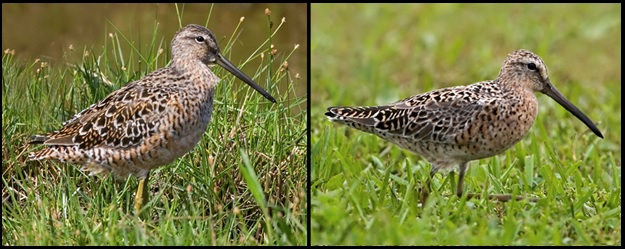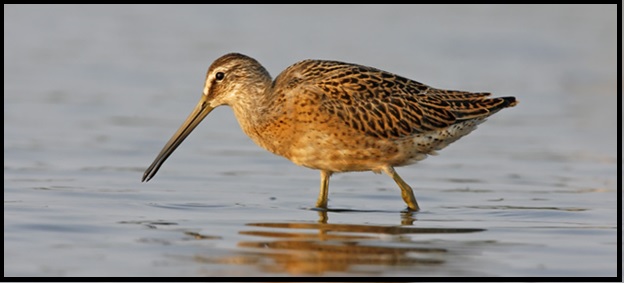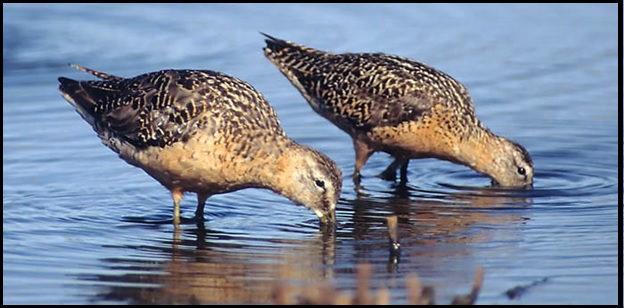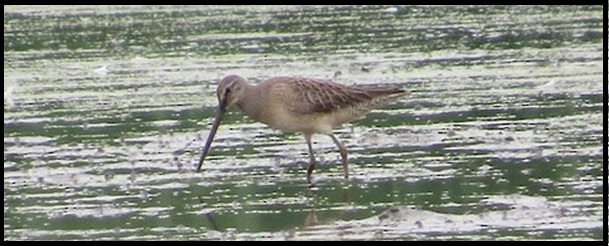DOWITCHER BASICS
Dowitchers are large-bodied, short-legged migratory shorebirds with extremely long bills relative to body length. In general, dowitchers (including juveniles) have warm orangeish or reddish underparts from late spring through summer and early fall, molting to cold gray upperparts with whitish underparts from late fall through winter and early spring. All feed belly-deep in shallow water on mud flats, probing the mud with a stitching “sewing machine” motion of their bills. Flight is purposeful and direct (often in small flocks). In flight, all show pointed wings and a distinctive and conspicuous wedge-shaped white rump patch extending all the way up the back.
The difficulties arise when trying to distinguish the two similar species that occur as migrants. To clarify, only two forms are expected in Illinois: the monotypic Long-billed Dowitcher (Limnodromus scolopaceus), and the “prairie race” Short-billed Dowitcher (Limnodromus griseus hendersoni). For brevity, Long-billed will be referred to as LBDO, and Short-billed (hendersoni “prairie race” ONLY) will be referred to as SBDO. Although it is possible that other forms of SBDO may occasionally occur as vagrants in Illinois, I am unaware of any accepted records of SBDO forms other than hendersoni.
CALLS
The most reliable way to distinguish the two forms year-round is by their diagnostic calls. LBDO flight call is a sharp “keek” given singly or in rapid series. SBDO flight call is a hollow, mellow “tu-tu-tu.” LBDO also often engages in soft chatter while foraging, unlike SBDO.
MIGRATION ENVELOPES
LBDO has a more northerly distribution (breeds in tundra of Alaska & northern Canada, winters in southern U.S. and Mexico). SBDO has a more southerly distribution (breeds in the prairie provinces of Canada, winters as far south as the West Indies, Central America, and northern South America). Therefore, it follows logically (based on distance traveled) that LBDO arrives earlier than SBDO in spring and conversely, later in fall than SBDO. April dowitchers are almost invariably LBDO. SBDO arrives later in spring, usually not until May and arrive in fall by early July.
BILL LENGTH
Per Paulson’s “Shorebirds of the Pacific Northwest” (1993), LBDO bill length ranges from 54-81 mm; SBDO bill length ranges from 51-69 mm. Therefore, dowitchers with very short bills CANNOT be safely identified to species based on that character alone. On the other hand, dowitchers with bill length at the long end of the spectrum can be safely identified as LBDO, especially if other dowitchers are nearby for comparison.
STRUCTURE
LBDO averages chunkier than SBDO, often (but not always) showing a rounded back and belly (as if it had swallowed a grapefruit). LBDO bill also averages longer, thinner-based, finer-tipped, and straighter than SBDO, but there is much variation between the two species.
SPRING DOWITCHER IDENTIFICATION
For all dowitcher identification, it is important to have a good grasp of bird topography and to have a decent understanding of terms like “tertials,” “scapulars,” and “flanks.” During the spring, all dowitchers are adults or near-adults that are either transitioning into breeding plumage or have attained full breeding plumage. Although it is true that LBDO in full breeding plumage have dark, brick-red underparts from throat to vent (more orange with some white in vent in SBDO), remember that spring LBDO migrants seen in Illinois are often still in transitioning molt and show a considerable amount of white on the underparts.

The most solid plumage clue one can use in separating spring adults (in fresh breeding or near-breeding plumage) of LBDO from hendersoni SBDO is the PATTERN OF SPOTTING AND/OR BARRING ON THE FORENECK, BREAST, AND BREAST SIDES. LBDO shows dark barring on the breast sides, with the foreneck and center of breast thickly spotted with black. On the other hand, adult hendersoni SBDO in breeding or near-breeding plumage show sharp ROUND BLACK SPOTS (no barring) on the breast sides, a clear foreneck with no spotting, and little or no spotting on the center of breast. Note also that breeding plumage LBDO shows a pattern of light and dark barring on the flanks (dark barring or spotting only in SBDO). Another very useful field mark in FRESH breeding plumage is the patterning of the lower scapulars: black centered feathers with bold white tips in LBDO vs. pale edges that wrap up and around the feather sides in SBDO.

FALL DOWITCHER IDENTIFICATION
From early July through the first week of August, the Illinois dowitcher migration is owned by adult hendersoni SBDO in fresh breeding plumage. Don’t expect to see much of anything else. Moving forward to the second week of August through the third week of September, the Illinois dowitcher migration changes considerably and is then dominated by juvenile SBDO (but smaller numbers of worn adult SBDO and LBDO may also occur). With a decent view, juvenile SBDO may be easily identified by their tiger-stripe, orange-buff internal markings on the tertials and scapulars.

Beware of worn adults seen in August, as they are notoriously difficult to identify. The rounder shape of LBDO is helpful in distinguishing between the two species, but not always reliable.

From late September through October (and into November), juvenile LBDO (molting into the gray winter plumage) is the expected form in Illinois. These are very different in appearance from juvenile SBDO. They are overall grayish, with a gray breast and only a touch of orange on the belly. There are no tiger-stripe orange-buff internal markings on the tertials and scapulars, but the scapulars are clearly outlined with bright reddish chestnut, which is a diagnostic distinguishing mark.

